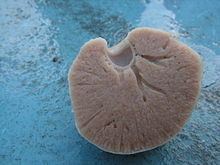Class Demospongiae Rank Species | Phylum Porifera Order Astrophorida | |
 | ||
Similar Geodia, Phakellia, Craniella, Astrophorida, Polymastia | ||
4 fate svampen geodia barretti
Geodia barretti is a massive deep-sea sponge species from the boreal waters of the North Atlantic, fairly common on the coasts of Norway and Sweden. It is a dominant species in boreal sponge grounds, from the North-East Atlantic and the North-West Atlantic. According to morphology and molecular data, this species belongs to the Geodiidae family.
Contents
- 4 fate svampen geodia barretti
- External morphology
- DNA barcodes
- Genomics
- Etymology
- Vernacular names
- Type material
- Phylogenetic relationships
- Biogeography
- Bathymetry
- Predators
- Associated macrofauna
- References
External morphology
Massive sponge, often irregularly lobate, whitish to light yellow color. The inside is light brown. Surface is smooth. Oscules are grouped in more or less shallow depressions (= preoscules) while pores are spread over the whole body. There is a distinct cortex about 0.5 mm thick, it is made of ball-shaped spicules called sterrasters.
DNA barcodes
Genomics
One meta-transcriptome was obtained by pyrosequencing from a specimen collected south of Bergen (Norway) in 2007. Double-stranded cDNA was sequenced on a GF FLX sequencer (Roche Applied Sciences/454 Life Sciences, Barnford, CT). rRNA ribo-tags revealed a microsymbiont community, dominated by group SAR202 of Chloroflexi, candidate phylum Poribacteria and Acidobacteria. The most abundant mRNAs coded for key metabolic enzymes of nitrification from ammonia-oxidizing Archaea as well as candidate genes involved in related processes.
Etymology
This sponge was named in honor of one of its discoverers, the biologist Lucas Barrett (1837-1862).
Vernacular names
This sponge is called "rutabaga sponge" in Norwegian (kålrabisvamp) and "football sponge" in Swedish (fotbollssvampdjur).
Type material
This sponge was collected by biologists Robert McAndrew and Lucas Barrett in 1855 on the South side of Vikna Island (formerly called Vigten or Vikten Island), North-Trøndelag, Norway, at a depth of 183 meters. It was later described by the British sponge taxonomist James Scott Bowerbank in 1858.
The holotype is a dry specimen stored at the Natural History Museum in London with the museum number BNHM 1877.5.21.1399. There are also slides of the holotype: BNHM 1877.5.21.1400 (one slide of surface and one spicule preparation) and BNHM 1877.5.21.1401 (slide of a section).
Phylogenetic relationships
According to morphology and molecular data, this species belongs to the family Geodiidae and to the genus Geodia. It also seems to belong to a clade of Geodia species that all have their oscules in depressions (including Geodia megastrella, Geodia hentscheli). This Geodia clade was given a PhyloCode name: Depressiogeodia.
Biogeography
G. barretti is present throughout the boreal waters of the North Atlantic, where water temperature is usually 3-9 degrees Celsius. This species is present on the Swedish west coast and all along the Norwegian coast and Svalbard.
One single specimen was formally recorded from the Mediterranean Sea, in the ‘Canyon des Moines’ (south Corsica), at 167 m (water temperature was 13 °C). Deeper specimens (1100-1700 meter depths) were also recorded off the Atlantic coast of Morocco (Ibero-Moroccan Gulf).
Bathymetry
It is found from 30 to 2000 meter depths. Most North-East Atlantic records are from the continental margins, between 200 and 500 m. In the North-West Atlantic (Grand Banks, Flemish Cap, Nova Scotia, and Davis Strait), it has been recorded between 410 and 1852 meter depths. Shallow specimens are common along the Norwegian coast, especially in fjords.
Predators
The sponge-feeding deep-sea chiton Hanleya nagelfar is often found on G. barretti in the North-East Atlantic. The parasitic foraminiferan Hyrrokkin sarcophaga is more rarely found living on G. barretti.
Associated macrofauna
G. barretti has less associated macrofauna than any of the other boreo-arctic Geodia species: only ten different species of epibionts were recorded vs. 62 for Geodia macandrewii.
